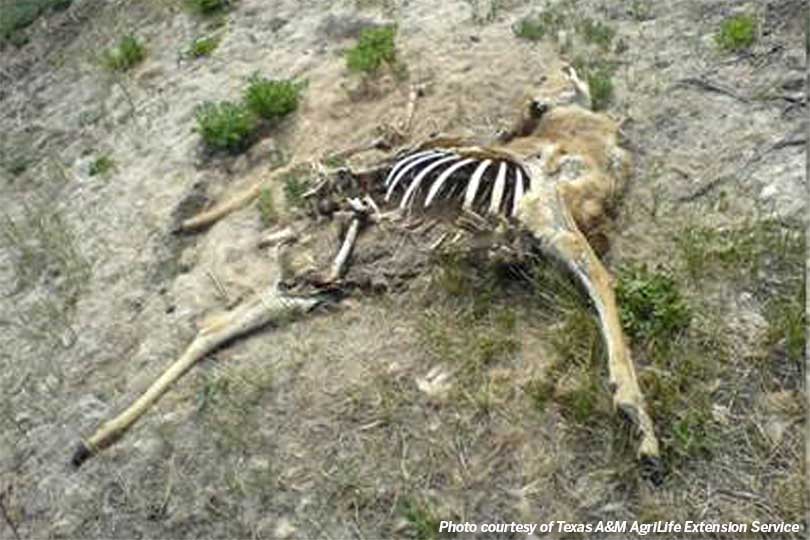The Texas Animal Health Commission (TAHC) has confirmed anthrax in about 30 white-tailed deer at a Kinney County Ranch in Southwest Texas.
This case has officials urging landowners to be mindful of the disease, to understand the warning signs, how to report it and how to prevent it to protect their livestock and wildlife.
“It’s important for area landowners to be cognizant of the fact that anthrax can and does occasionally occur here and to be mindful of the conditions that cause it,” Emily Grant, AgriLife Extension Agriculture and Natural Resource agent for Kinney County, told AgriLife Today.
Sheep, goats, horses, cattle, swine, domestic or exotic deer and humans are common species that are susceptible to anthrax, according to Dr. Maureen Frank, AgriLife Extension wildlife specialist, Uvalde.
Frank said wild deer are more prone to the disease because they move around and spread it to other areas.
Most cases of anthrax in Texas occur in Southwest Texas, including portions of Crockett, Edwards, Kinney, Maverick, Sutton, Uvalde and Val Verde counties.
The spores that cause anthrax thrive in warm weather, but there have been cases of anthrax during the winter months. Soil types and weather are factors that cause the spread of the disease.
“It is caused by the bacterium Bacillus anthracis, which produces spores as a way to survive unfavorable conditions,” John Tomecek, AgriLife Extension wildlife specialist in San Angelo, told AgriLife Today. “These spores, which can lie dormant in the soil for many years, are largely responsible for the disease. But unlike weaponized anthrax, spores are not typically airborne in sufficient concentrations to cause infection.”
Anthrax outbreaks are usually spurred by mild, wet winters and springs followed by dry spells, according to Tomecek. He said surface water from rains relocate the spores in the dusty soil and create “hot spots” where animals graze.
Symptoms of the diseases include lethargy, a loss of coordination, staggering and difficulty breathing, according to Frank.
“A symptom characteristic of anthrax is blood oozing from the animal’s orifices—the nose, mouth and anus—although it is important to note that not all affected animals will display this symptom,” Frank said.
If a landowner notices any of these symptoms, they should be reported to TAHC or seek assistance from a veterinary professional. Officials will then give advice on how to best manage the situation.
“Report any suspected instance of anthrax to the veterinarians and they will send tissue samples from suspected cases to the Texas Veterinary Medical Diagnostic Laboratory for confirmation,” Frank explained.
Tomecek and Frank said the prompt reporting of instances in which animals are acting abnormally and exhibiting symptoms known to be associated with anthrax are key to the early detection and management of outbreaks.


Very helpful. Please keep writing articles. Every Friday my Ag class writes a report about current Ag related events and this is the kind of stuff that interests me and my classmates.
Great! We’re glad you’re able to use our daily stories for class assignments.
Bob: Glad to Hear It! I’m Dr. Tomecek from Texas A&M. Follow the link for a fact-sheet that Dr. Frank and I wrote on the subject.
http://agrilife.org/texnat/files/2016/09/EWF-060.pdf
We are buying land in Edwards county and deer we saw looked very healthy have u seen any there in a while?
I have a deer lease in SONORA AND WE HAVNT SEEN A DEER IN A FEW MONTHS
Spoke with a game warden in Crockett county. Southeast section of the county saw a 65 to 90 % kill rate.